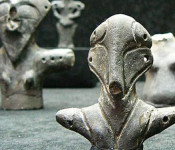within World’s Black Archeological Market
Monday 18 October 2021 at 11:37 am
#goddess of old Europe #art and World’s Black Archeological Market
Neolithic European wisdom, symbols and divine learning from
Marija GIMBUTAS Earth Fertility of old Europe
Ever since its first discovery in 1908 by the Serbian archaeologist Miloje Vasić, Vinča culture, a Neolithic settlement that spanned most of Serbia, parts of Romania, Bulgaria & Macedonia, has been of great interest to the lay public and scientists alike.
Middle Bronze Age Goddess 1800 BC
From Neolithic monuments to Roman Villas and prehistoric figurines the river basin of Danube (Serbia, Romania, Bulgaria) has proved rich for treasure hunters over the years
In 2005, Police in central Germany found the artifacts that date to the Neolithic period and are believed to belong to the Vinca, in a sports bag belonging to two Serbs. Last year, a 2,000 year old Roman monument weighing half a ton was stolen in 24 hours after the find. Such epigraphic monuments, stone monuments with Latin engraving text) are extremely rare in the world so the value is extremely high.
With 100s of objects discovered, Serbia would ranke among the first in Europe for finds declared if there is not a huge Archeological Black Market that leads these priceless artifacts into foreign private hands. If you're into stats, there’s every chance with every new dig unearth more hugely significant finds. The found and stolen monument on the territory of Serbia is unique in the world because they are highly preserved with Latin (Greek) inscription in 15 lines. Based on the inscription on the monument, an expert from the National Museum found that the monument belonged to a chivalrous man. He commanded various military departments and took part in the war with the Dacians and Parthians. The special value of this monument for Serbia and Belgrade was in the fact that it was found in its original place: the ancient Singidunum.
Now Information about the monument is included in the Interpol database of stolen archaeological items so that thieves can never sell it to a museum but still it goes to someelse’s hands.
Read more
Learning from ancient art about aXuM
Friday 15 October 2021 at 1:26 pm
The Obelisk of Axum (ሓወልቲ ኣኽሱም) and divine Ark of the Covenant
The Obelisk of Axum (ሓወልቲ ኣኽሱም) is a 400 AC, 24 metre obelisk, weighing 160 tonnes, now in the city of Axum in Ethiopia. The obelisk or Hawelt in Ge'ez in Axum was a "marker" for underground burial chambers. The largest were for royal burial chambers. In Ethiopia there are only a few large ones, and hundreds of smaller ones in various "stelae fields". Near the top of the stele a small house like object is carved in relief, claimed by Ethiopians to house the original Ark of the Covenant.
Salt and Havell (1809) The Obelisk at Axum
In the 19th century, of the three major "royal" stelae, only this one, King Ezana's Stele remained erect, visible in the print "The Obelis of Axum" of Henry Salt (1780–1827).
Salt and Havell (1809) The Obelisk at Axum, Twenty-Four Views in St. Helena, The Cape, India, Ceylon, The Red Sea, Abyssinia and Egypt, London: William Miller. 1809
The Axum obelisk is regarded as one of Ethiopia's national religious treasures.
The stele was one of fifty obelisks in Axum at the time of the discovery, in 1937. Italian troops took it to Rome, Italy, cut into five pieces and transported by trucks.
“A crowd of Ethiopian ministers, priests and other VIPs cheered and clapped as it landed.” News reported the return of the obelisk. 24m tall, it weighs 160 tons, this 1,700 years old monument was welcomed by chanting priests.
Many Ethiopians see the obelisk as a vital national symbol. It was dismantled by Italian experts in 2004 in readiness for its journey home. The journey costed Italian government 6m euros. The 160-ton monument had to be broken into three pieces.
Axum was the largest, heaviest object ever transported by air. Heaters were installed and the obelisk was wrapped in steel bars for the six-hour flight. The airstrip at Axum had to be upgraded to handle the weight of the aircraft, and radar was installed.
Read more
Learning from Van Gogh & Hokusai about 19th Century Art Great Wave
Thursday 30 September 2021 at 9:19 pm
19th Century art & Search for Indefinite, Infinite Impression consciousness
Presence or Absence of divine Learning from Van Gogh & Hokusai by Nataša Pantović
The late 1800s was the time of Impressionism as a radical art movement , centered around Parisian painters, the wave that rebelled against classical subject and gave respect to Mother Nature.
Travelling to their thought-form, Vincent van Gogh to the artist friend Emile:
“But now look, ... you surely can't seriously imagine a confinement like that, in the middle of the road, with the mother starting to pray instead of suckling her child? Those bloated frogs of priests on their knees as though they're having an epileptic fit are also part of it, God alone knows how and why!
No, I can't call that sound, for if I am at all capable of spiritual ecstasy, then I feel exalted in the face of truth, of what is possible, which means I bow down before the study - one that had enough power in it to make a Millet tremble - of peasants carrying a calf born in the fields back home to the farm.
That, my friend, is what people everywhere, from France to America, have felt. And having performed a feat like that, can you really contemplate reverting to medieval tapestries? Can that really be what you mean to do? No! You can do better than that, and know that you must look for what is possible, logical and true.”
Letter from Vincent van Gogh to Emile Bernard, Saint-Rémy, 1889
“Now to enlighten you, my dear M. Van Gogh, ... I am searching for and at the same time expressing a general state of mind rather than a unique thought, to have someone else's eye experience an indefinite, infinite impression. To suggest a suffering does not indicate what kind of suffering: purity in general and not what kind of purity. Literature is one (painting also). Consequently, suggested and not explained thought.”
Letter from Paul Gauguin to Theo van Gogh. At this time, Vincent was 36 year old.
The two striking waves in Blue: 2 Great Waves - Hokusai 1883 & Van Gogh 1989
First seen outside Japan in the 1880s, Van Gogh's brother was one of the first Europeans to collect Japanese prints and has admired Japanese art.
The Starry Night Vincent Van Gogh, 1889 & Japanese print Hokusai Great Wave 1833
Read more
Learnings from Plato's Republic
Wednesday 25 August 2021 at 7:35 pm
History repeats itself and Plato about Arts
History repeats itself. And people forget about history. There is no easy fix. It is easy to think that wars are in the past, that society has changed and it will never happen again. As memory fades, Gaia’s events from the past can become events of the present. The more things change, the more they stay the same. What we are seeing is that ‘digital’ acts as a magnifier, and accelerator. The problem is still the same. The isolation of East and West, North and South. Wealth inequality is a social and civic conversations that is not new but that has been catalysed through digital media.
Manuscript from the 300 AC, containing fragments of Plato's Republic.
Plato in the Republic rejects any form of illusionism in art. He calls it mimesis or ‘imitation’. This has also created a question what is the Greek word “mimesis”? And why does this matter?
What we have not full knowledge of, we cannot reproduce. Presumably this is the reason why all the monotheistic religions (Protestant Christianity, Islam, Judaism) had an explicit problem with art and artists trying to imitate the knowledge of god, its image, his son, soul, Universe, etc. The imitation occurs in many instances, when an artist uses a portrait of a dead person to recreate his-own interpretation of the person. But Plato goes beyond it.
Read more
Learnings from Cyrillic Alphabet and DNA Analysis
Tuesday 24 August 2021 at 10:43 am
Etruscans origins & Slavs
Learning from Cyrillic Alphabet & DNA Analysis, #education #consciousness
History is a fascinating subject. Researching god or consciousness even more so! We read amazing accounts about ancient wisdom traditions such as Platonism, Orphism, Orthodox Christianity, and in China Taoism, and neo-Confucianism.
The Big Dipper Ancient Symbol Sky 6 Cycles
The insights from these traditions intersect with recent findings in metaphysics or biology. What brings the two into resonance is their mutual commitment to speak of the matter as alive. The four elements expressed through trinity that are defined by entangled triangle of relationships reflected in our language development.
Another visit to Serbia, this summer, and I was back researching the same scientific question, same puzzle that has certainly no answers yet it is an interesting exploration.
Were Slavs in Balkan as early as 431 BC?
Read more




